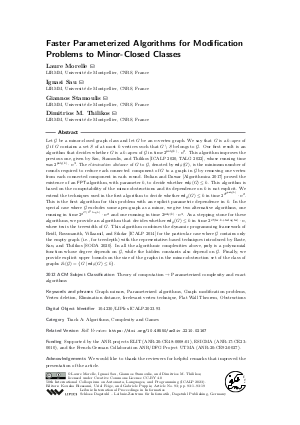@InProceedings{morelle_et_al:LIPIcs.ICALP.2023.93,
author = {Morelle, Laure and Sau, Ignasi and Stamoulis, Giannos and Thilikos, Dimitrios M.},
title = {{Faster Parameterized Algorithms for Modification Problems to Minor-Closed Classes}},
booktitle = {50th International Colloquium on Automata, Languages, and Programming (ICALP 2023)},
pages = {93:1--93:19},
series = {Leibniz International Proceedings in Informatics (LIPIcs)},
ISBN = {978-3-95977-278-5},
ISSN = {1868-8969},
year = {2023},
volume = {261},
editor = {Etessami, Kousha and Feige, Uriel and Puppis, Gabriele},
publisher = {Schloss Dagstuhl -- Leibniz-Zentrum f{\"u}r Informatik},
address = {Dagstuhl, Germany},
URL = {https://drops.dagstuhl.de/entities/document/10.4230/LIPIcs.ICALP.2023.93},
URN = {urn:nbn:de:0030-drops-181458},
doi = {10.4230/LIPIcs.ICALP.2023.93},
annote = {Keywords: Graph minors, Parameterized algorithms, Graph modification problems, Vertex deletion, Elimination distance, Irrelevant vertex technique, Flat Wall Theorem, Obstructions}
}

 Creative Commons Attribution 4.0 International license
Creative Commons Attribution 4.0 International license
